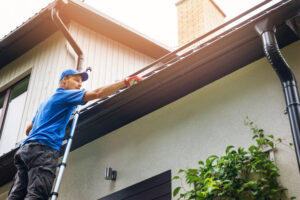When summer storms roll in, your gutters are your home’s first line of defense against water damage. Your gutter system is designed to catch rainwater from your roof and direct it safely away from your home, including the siding, windows, and foundation. But if your gutters are clogged, cracked, or pulling away from the roofline, they can’t do their job—and that can lead to a mess of problems like roof leaks, mold, and even structural issues.
Luckily, a little gutter preparation now can save you a lot of stress (and money) later. In this guide, we’ll walk you through simple, must-do steps to prepare and ensure your gutters are ready for anything the summer storms can bring.
Signs Your Gutters Aren’t Ready for Storm Season
Not sure if your gutters are storm season-ready? Don’t worry—your home usually gives you a few warning signs. Catching these red flags early can safeguard your home and help you avoid potential damage later on.
Here’s what to watch for:
-
Water overflowing during rain – If water pours over the edge of your gutters, it’s a clear sign of a clog. A well-maintained gutter system should allow water to flow freely toward the downspouts.
-
Peeling or bubbling paint – Moisture around failing gutters often leads to paint damage on siding or trim, a clue that water isn’t being directed properly.
-
Mildew or algae at the foundation – This suggests the downspouts aren’t diverting water away from your foundation, leading to puddles and growth.
-
Sagging or pulling gutters – If they’re detaching or weighed down, it’s time to check for damage or debris, especially ahead of summer storms.
-
Interior water stains – This could mean water is leaking in due to damaged gutters or a failing gutter system.
7 Steps to Prepare Your Gutters for Summer
Before the storm season arrives, here are the essential steps to prepare and protect your home.
1. Clean Your Gutters
Clean your gutters regularly to remove leaves, twigs, and debris that can clog your gutters and prevent water flow. Whether you go the DIY route or hire a professional gutter cleaner, this is a crucial first step in gutter maintenance.
2. Inspect Your Gutters for Damage
After cleaning, carefully inspect your gutters for leaks, cracks, rust, sagging sections, or mold. These are all signs your gutters for summer storms may not hold up. If you find significant issues, a gutter replacement or repair may be necessary.
3. Check the Roof
Loose shingles or flashing can blow off in high winds and clog your gutters. A professional inspection can help ensure your roof and gutter system are working together to protect your home from water.
4. Trim Trees and Bushes
Storms often bring high winds, which can knock down branches that clog or damage your gutters. Keep nearby trees trimmed to reduce debris entering your gutters.
5. Check the Downspouts
The downspouts are key to directing water away from your home. Ensure they’re firmly attached, angled properly, and clear of obstructions. Broken or detached downspouts can lead to overflow and potential damage.
6. Secure Outdoor Items
Loose furniture and décor can damage your gutters if blown around during a summer storm. Bring in or tie down anything that could become airborne.
7. Install Gutter Guards
Gutter guards act as a barrier against debris. Installing gutter guards will significantly reduce the frequency of gutter cleaning and maintenance, while allowing water to flow freely during heavy storms. There are different types of gutter guards available to suit your system and roof type.
How to Test Downspouts Before Summer Storms
Not sure if your downspouts are working? Here’s how to check:
Run a hose from the roof into your gutter system. If water pools or exits slowly, there may be a clog. Try using a plumber’s snake to clear it. If leaks occur or water fails to reach the end, it’s time for professional gutter services or a downspout replacement.
Risks of Skipping Summer Gutter Prep
Ignoring your gutters for summer can result in:
-
Roof damage from standing water
-
Mold and mildew inside the home
-
Foundation cracks due to improper drainage
-
Pests nesting in clogged gutters
-
Costly structural repairs
Gutters can’t do their job when neglected. Taking time for gutter preparation can help you safeguard your home against potential water damage.
Final Thoughts: Prepare Your Gutters for Summer
Preparing your gutters for summer is one of the most effective ways to protect your home from the effects of heavy summer rains. From installing gutter guards to scheduling a professional gutter inspection, the steps to prepare are simple but vital.
Whether you need a full gutter installation, seamless gutter upgrade, or just regular upkeep, make sure your gutters and downspouts are ready to handle anything summer storms can bring. A little effort now can save you thousands in potential damage to your home’s roof, walls, and foundation.
FAQs
How do I keep my gutters clear during summer?
-
Clean at least twice a year
-
Install gutter guards
-
Check downspouts and attachments
-
Ensure all fasteners are secure
When should I replace my gutters?
-
If they’re rusted, sagging, or detached
-
When repairs exceed replacement cost
-
If upgrading to more durable materials like seamless gutters or copper gutters
What happens if gutters overflow during storms?
Overflow causes roof and foundation damage, mold, and interior water issues. Make sure your gutters are properly aligned and unclogged.
Can I DIY gutter cleaning and repairs?
Yes—for single-story homes and minor jobs. For safety and quality, hire a professional gutter specialist for major work, inspections, or gutter replacement.










